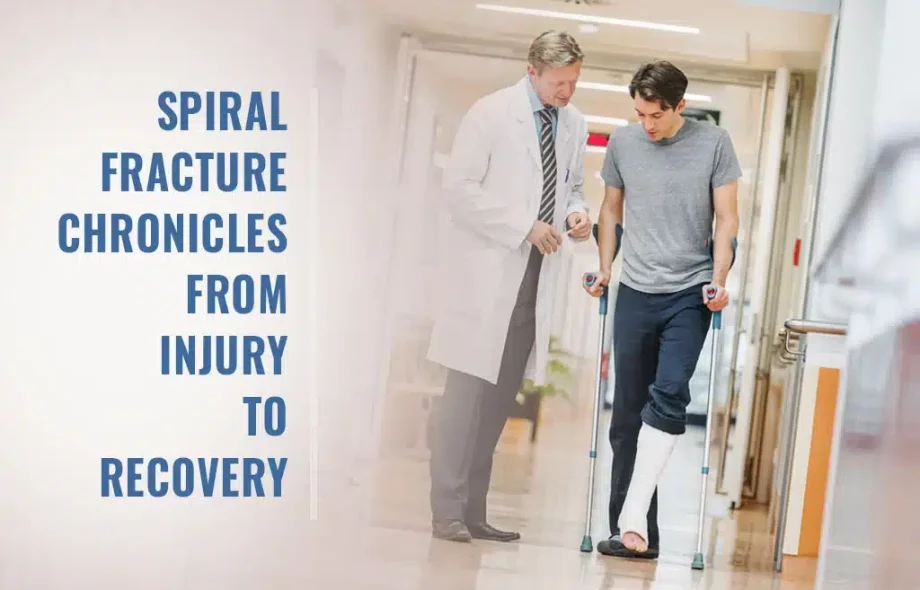Introduction
A spiral break is a serious bone injury that needs immediate medical attention. Whether it happens during sports, accidents, or a simple fall, understanding this injury can help in responding quickly and avoiding long-term damage.
What Is a Spiral Break?
A spiral break, also known as a torsion fracture, occurs when a long bone (like the femur or tibia) is twisted with excessive force. This causes the bone to fracture in a spiral or corkscrew pattern. Unlike a clean break, this type of fracture usually involves more soft tissue damage and can be more painful.
Common Bones Affected
Femur (thighbone)
Tibia and Fibula (lower leg bones)
Humerus (upper arm bone)
Radius and Ulna (forearm bones)
Causes of Spiral Break
A spiral fracture happens due to a twisting force on the bone. Some common scenarios include:
1. Sports Injuries
High-impact sports like skiing, football, and wrestling often involve quick twists or turns, which can lead to spiral breaks.
2. Falls and Accidents
Slipping on wet surfaces or falling from a height can apply unexpected rotational force to limbs, causing this kind of break.
3. Car Accidents
The impact and rotation in vehicle collisions may result in spiral fractures, especially in the legs.
4. Child Abuse or Neglect
In rare and unfortunate cases, spiral fractures in infants can be a sign of physical abuse due to unnatural twisting of the limbs.
Symptoms of a Spiral Break
Recognizing the signs of a spiral break early can help you get timely care:
Intense pain around the fracture site
Swelling and bruising
Inability to move the affected limb
Deformity or twisting in the appearance of the limb
A cracking or popping sound at the moment of injury
How Is It Diagnosed?
Doctors at ER OF WATAUGA use several steps to diagnose a spiral break:
1. Physical Examination
The doctor will look for swelling, tenderness, and limb alignment.
2. X-Rays
This is the most common way to see the spiral pattern of the break.
3. CT Scans
For more complicated breaks, CT scans may offer detailed 3D images.
Treatment Options for Spiral Break
Treatment depends on the severity and location of the break.
1. Immobilization
Using a cast or splint to hold the bone in place while it heals.
2. Surgery
In severe cases, surgery might be necessary. Metal plates, rods, or screws may be used to realign the bone.
3. Pain Management
Pain relievers and anti-inflammatory medications are given to reduce discomfort.
4. Physical Therapy
After the bone begins to heal, therapy helps regain strength and movement.
📍 Note: At ER OF WATAUGA, patients receive round-the-clock emergency care from expert orthopedic teams.
Healing Time and Recovery
A spiral break may take anywhere from 6 to 12 weeks to heal depending on:
Age
General health
Bone affected
Treatment type
Tips for Faster Recovery
Follow the doctor’s instructions closely
Attend all follow-up appointments
Do gentle exercises as advised
Eat bone-healing foods like dairy, leafy greens, and nuts
Complications If Not Treated
Ignoring or delaying treatment of a spiral break can lead to:
Permanent limb deformity
Chronic pain
Improper bone healing (malunion)
Risk of arthritis in the affected joint
Why Choose ER OF WATAUGA for Spiral Break Treatment?
ER OF WATAUGA offers fast, accurate, and compassionate care for bone injuries, including spiral fractures. Here’s why patients trust us:
24/7 emergency care
On-site X-rays and imaging
Board-certified physicians
No long wait times
Personalized treatment plans
Prevention Tips
While not all injuries are avoidable, you can reduce your risk of spiral fractures by:
Wearing proper safety gear during sports
Using handrails on stairs
Avoiding wet or slippery surfaces
Keeping bones strong with a healthy diet and regular exercise
When to Visit the Emergency Room
Seek immediate help at ER OF WATAUGA if:
You heard a snap or crack during injury
The limb looks twisted or deformed
Severe swelling and pain occur
You are unable to move the limb
FAQs About Spiral Break
What is the main cause of a spiral break?
A spiral break usually results from a twisting force applied to the bone, commonly seen in sports injuries or accidents.
Is a spiral break more serious than a regular fracture?
Yes, because the twisting motion often causes more tissue damage and makes the fracture harder to treat.
How long does it take to heal?
Most spiral fractures heal within 6–12 weeks, but this varies by individual case and treatment.
Will I need surgery?
Not always. Mild cases may only require casting, but severe or displaced fractures often need surgical intervention.
Can a child recover from a spiral break?
Yes, children typically heal faster due to their strong bone regeneration capabilities. However, they must be monitored closely.
 :
https://erofwatauga.com
:
https://erofwatauga.com

